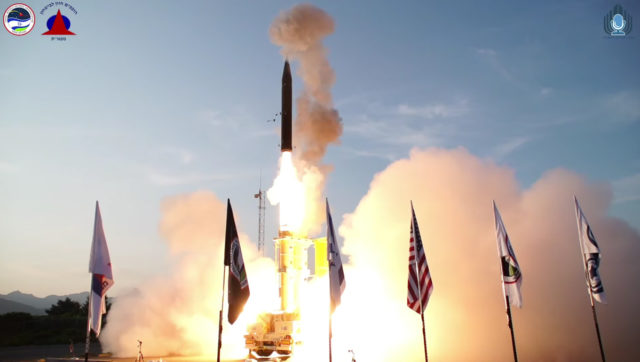
The recent Arrow 3 missile test in Alaska, announced on Sunday, was nearly taken out by a rogue. Not a rogue missile, mind you, but a rogue amendment to the to the National Defense Authorization Act (NDAA). Earlier this month, Congresswoman Lois Frankel (D-FL) proposed the following language:
“None of the funds authorized to be appropriated by this Act or otherwise made available for the Department of Defense for fiscal year 2020 may be made available for the research, development, testing, evaluation, procurement, or deployment of a United States shorter- or intermediate-range ground-launched ballistic or cruise missile system with a range between 500 and 5,500 kilometers…”
The prohibition was aimed at the Trump administration’s decision to withdraw the United States from the Intermediate Nuclear Forces (INF) Treaty. But according to one analyst:
(It) would prohibit funding for the U.S.-Israeli cooperative Arrow-3 missile defense interceptor and also severely impact the planning, execution, and evaluation of flight test of the United States Ballistic Missile Defense System (BMDS), integrated testing with friends and allies… The U.S.-Israeli cooperative Arrow-3 missile defense interceptor would be subject to the prohibition in the amendment and as a result the Missile Defense Agency would be unable to provide (funding) as required by the U.S.-Israeli Memorandum of Understanding…
The Frankel amendment actually passed. Language in a later bill removed Israel from the line of fire, so to speak, but it was close.
So, Israel, in cooperation with the U.S. Department of Defense, tested the Arrow-3 missile in Alaska. The performance of Arrow 3 was outstanding and the resulting video offers an opportunity for Americans and Israelis to watch U.S.-Israel strategic cooperation in action. It is a reminder, as well, how far two democratic, technologically advanced countries can go to make the world safer for ourselves and our allies (And our adversaries? Reagan was serious when he proposed sharing missile defenses with Russia at the height of the Cold War.) Thirty-six years of doing what “the experts” said could not be done.
For Americans, watching a missile hit a missile conjures up Ronald Reagan’s seminal missile defense speech, the moment defense became part of the definition of deterrence.
What if free people could live secure in the knowledge that their security did not rest upon the threat of instant U.S. retaliation to deter a Soviet attack, that we could intercept and destroy strategic ballistic missiles before they reached our own soil or that of our allies?
It was called “Star Wars” because it seemed possible only in a galaxy far, far away — a joke at Reagan’s expense. Naysayers far outnumbered believers, but Strategic Defense — renamed Ballistic Missile Defense — has become routine. Patriot, Aegis and THAAD are part of the American and allied defense lexicon and hitting a missile with a missile is what we do.
And so does Israel.
Arrow — Israel’s domestically developed missile defense system — became operational in 2000. But long before that, in 1986, the U.S. and Israel signed a Memorandum of Understanding (MOU) on co-funding and in 1988, the DOD Strategic Defense Initiative Organization (SDIO) [later renamed Ballistic Missile Defense Organization (BMDO)] placed an order for an Arrow 1 technology demonstrator. A BMDO news release following the first successful Arrow test announced:
The United States and Israeli engineering teams are very satisfied with the preliminary test results… The information gained from the program has application in several U.S. missile defense programs.
Arrow II, Arrow III, Iron Dome and David’s Sling followed with American participation. Arrow IV is more than a gleam in scientists’ eyes.
American and Israeli missile technology, missile capabilities and production capabilities are closely interwoven. They can be because our defense goals are interwoven. The ability to defend civilians from an enemy — regardless of the weapon the enemy brings to the battlefield — is the first and highest priority of both governments. Defense, in Israel’s case in particular, has allowed the government to make decisions in the face of enemy fire that would not have been possible with ever-more precise rockets and missiles raining down on Israeli civilians from Hamas in Gaza. So Palestinians, too, benefit from Israeli missile defense.
Our allies are lining up as well. Israeli technology is part of the defenses of Europe and Asia, and Israel is in talks with some European countries for Iron Dome, which already protects NATO forces in Afghanistan. South Korea is purchasing additional units of Israel’s Green Pine radars. India has tried to purchase the Arrow system (the U.S. vetoed it) and Norway and Singapore are edging closer. In 2015, the Gulf Arab states were reported interested in Arrow — in recognition of their shared concerns about Iranian missiles. Since then, Israel has participated in military exercises with more than one potential partner under U.S. auspices
At the edge of Alaska, Israeli and American cooperation and coordination produced another test of a more humane way for “free people to rest secure.” Just watch out for those rogue amendments.

